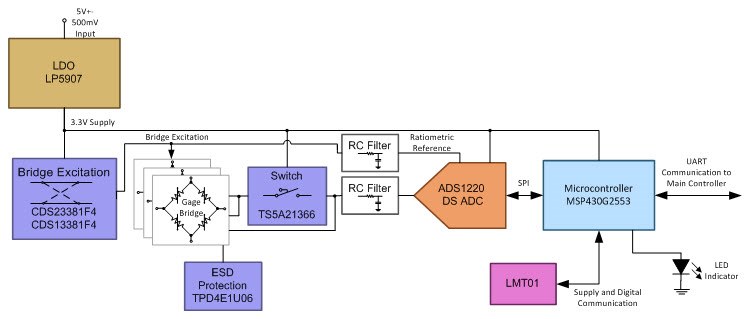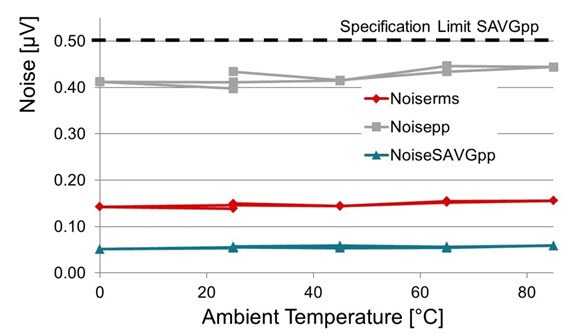SSZTAQ3 october 2016 ADS1220 , ADS1231 , CSD13381F4 , CSD23381F4 , LP5907 , MSP430G2553 , TS5A21366

Let’s say that you decided to try out a new recipe to surprise someone, but it doesn’t come out quite right. Cooking is an exact science. You could get results eventually through trial and error, but weighing the ingredients would have helped you get it right the first time.
To achieve better results when you cook, you need food processors, ovens and cooktops that integrate weighing capabilities. Guided cooking functions even enable convenient loading of recipes and target weights directly from files or from the internet. Microwave ovens can sense the weight of food automatically and adjust defrosting times accordingly.
The scales in these appliances need to be accurate. Everyone has likely experienced the effect of too much salt or spices in a dish. Accurate weighing of ingredients is critical for the desired outcome, and resolution needs be at or below a gram.
Since most ingredients weighed are less than 1kg, you might assume that 1/1000 resolution is good enough for a resolution of a gram. But for stability, damping and firm standing, the weight gauges are integrated into the feet or fixtures of the appliance. So the total weight of the appliance, food, pots and attachments bear upon the gauges. The total weight can reach 20kg and this maximum determines the dynamic range. Cost-effective wired-or configurations of multiple weighing scale gauges have sensitivities as low as 0.2mV/kg. A stable display requires a peak-to-peak reading noise to be a fraction of a gram. To reliably achieve accuracy less than 1 gram, less than 100nVpp noise and 20 bits of effective resolution are required.
The 1g Resolution over 15kg Range Sub-100nVpp Noise Front-End Reference Design demonstrates the integration of a high-resolution weighing function into smart kitchen appliances. Given the significant levels of switching supply noise and rapid temperature changes, drift and interference are common signal-integrity challenges in appliances. The reference design’s highly integrated precision, 24-bit, analog-to-digital converter (ADC), AC excitation and robust filtering suppress drift and interference and ensure consistent performance in tough environments. Figure 1 depicts the reference design’s block diagram.
 Figure 1 Sub-100nVpp Noise Front-end
Reference Design Block Diagram
Figure 1 Sub-100nVpp Noise Front-end
Reference Design Block DiagramThe outputs of the strain gauge bridge’s resistive load cells are connected through TS5A21366 low-leakage switches to the ADS1220 precision ADC. The MSP430G2553 microcontroller computes the sliding average of the raw data and controls the front-end operation and chopping of the resistive strain gauge bridge with a configuration of compact CSD23381F4 and CSD13381F4 transistors. The LP5907 LDO and filters robustly suppress noise pickup. This front end demonstrates an effective resolution below a 100nVpp noise readout of resistive load cells, even in the presence of more than ±500mVpp of switching noise.
The test data in the reference design guide demonstrates full performance even when the board is integrated into an operating food processor, supplied directly by a noisy switching supply, and is in close proximity to several noise sources, including the mixer’s running motor. As Figure 2 shows, the noise of the front end is filtering significantly below the 100nV peak-to-peak target over temperature.
 Figure 2 Noise Level of Raw Data as RMS
Value (Noiserms) and Peak-to-peak Value (Noisepp) and Peak-to-peak Value with
Sliding 1s Average (NoiseSAVGpp) in Microvolts
Figure 2 Noise Level of Raw Data as RMS
Value (Noiserms) and Peak-to-peak Value (Noisepp) and Peak-to-peak Value with
Sliding 1s Average (NoiseSAVGpp) in MicrovoltsThe reference design’s accuracy results from the ADS1220 ADC’s benefits, which include:
- High integration, including a low-noise programmable gain amplifier, line frequency filter and flexible multiplexer, to enable a compact and robust system design.
- Sub-410nVpp input referred noise at a gain of 128V/V 20SPS data rate, reaching an effective resolution of 20 bits with averaging over 1s to enable <1g resolution.
- A single-cycle settling digital filter response eases the chopping of gauges, offset cancellation, and guarantees the lowest gauge drift. Such filters enable data capture directly after polarity reversal, as the conversion result is valid within the first conversion cycle. This maximizes the number of valid conversion results, which are not effected by digital filter settling.
The low-noise LP5907 LDO’s outstanding high-frequency power-supply rejection ratio – greater 60dB even when supplying 250mA of output current – suppresses switching supply noise in the 100kHz range and other noise pickup very reliably.
Another option for highly cost-constrained applications is to use the ADS1231 precision delta-sigma ADC, especially if chopping at bridge level, suppressing gauge drift, or if multiplexing of multiple gauges is not required.
So if you want to ease getting cooking and baking recipes conveniently right the first time, consider integrating accurate weighing capabilities into your kitchen appliance with our reference design.
 Figure 3 Anyone Ready for Some Stollen
and Christmas Cookies?
Figure 3 Anyone Ready for Some Stollen
and Christmas Cookies?Additional Resources
- Learn more about TI’s appliance solutions and precision ADCs.
- Check out these reference designs:
- Enjoy these blog posts: